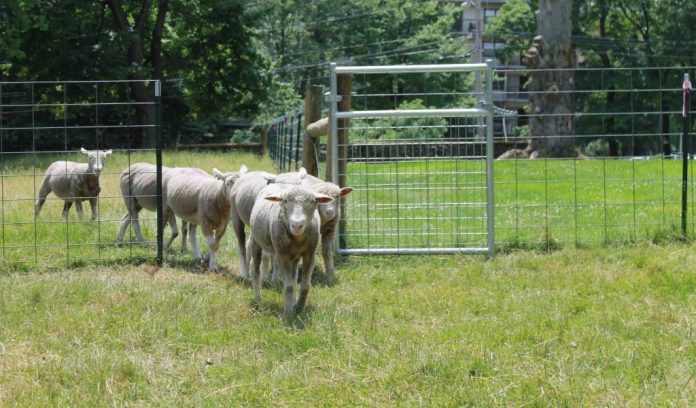
AKRON — A vacant lot can be full of possibilities. A vacant lot full of sheep, however, is full of productivity.
And that’s what brought the Urban Shepherds project into being.
History
The Urban Shepherds project started in 2011 with a vacant lot in Cleveland. Laura DeYoung Minnig, executive director for Urban Shepherds, said Cleveland had just changed its zoning laws to allow small ruminants in the city. Rather than spend money on mowing, the lot owners decided to start mowing with sheep.
“We’re creating something more productive than grass clippings. We’re creating meat and wool,” Minnig said.
Some sheep remain at the original Cleveland Shoreway location, and in 2016, Urban Shepherds also began working with The Foundry Project in Cleveland, making it their Cleveland office and training site.
The Foundry Project is creating a sustainable farm on the site of an abandoned foundry. Minnig said the farm will include fish, an orchard and sheep and will provide after-school programs for students.
Mutton Hill
In addition to the sheep in Cleveland, Urban Shepherds has a project in Akron at Mutton Hill, where Akron founder Simon Perkins lived and raised sheep in the 19th century. The sheep were first moved to Mutton Hill for the summer of 2016 and returned this year for another summer.
Minnig views the return of sheep to the vacant area at Mutton Hill as a way of rebranding the historic property. The vacant area behind Perkins Stone Mansion — a large, grass- and tree-filled lot — was adapted for sheep by adding fencing.
The sheep come from Spicy Lamb Farm, Minnig’s farm, but Urban Shepherds is interested in working with other farmers to sell feeder lambs for future Urban Shepherds projects like the ones in Akron and Cleveland. They are also open to negotiating leasing for dry ewes for future projects.
Urban-rural
Minnig said much of the program involves urban-rural shepherd matching. Farmers need to know their sheep will be well taken care of and, in order to make the program work with urban caretakers, farmers have to be willing to “take someone under their wing,” Minnig said.
The caretakers are usually members of the community who have stepped up to the job, and Urban Shepherds trains them to take care of the sheep. Training covers conservation grazing, the shepherd’s calendar, common sheep ailments and sheep handling.
Minnig said Urban Shepherds also equips caretakers to answer questions and concerns from the public.
Edie Steiner, the Akron coordinator for Urban Shepherds and caretaker for the sheep at Mutton Hill, is a herding dog handler in Akron who had never raised sheep before getting involved with the Urban Shepherds project. She regularly brings her three border collies to Mutton Hill when she takes care of the sheep, and gives herding demonstrations weekly.
Community
Urban Shepherds also works to engage the community in the areas where it has launched projects. An apartment building across the street overlooks the sheep at Mutton Hill, so many residents are able to see the sheep from their homes.
Steiner said the project “gets the community curious. There are people out here every night of the week” and some families take regular Friday night walks to see the sheep.
Minnig added, “There were some folks that never left their apartments and now they come here.”
Education
Summer is the easiest time of year to care for sheep, since there is no lambing, breeding or winter housing. Urban Shepherds uses feeder lambs, which arrive in spring and go to market in fall, and dry ewes, which graze for the summer and return to their farms in fall.
The main concerns are giving sheep access to water and minerals, rotating the pastures for parasite management and checking the sheep for ailments.
Goals
Minnig said Urban Shepherd’s long-term goals include starting at least one more pilot project in a new location, being able to help fund projects in other areas with loans and expanding overall. Urban Shepherds is currently working on getting grant money to help fund pilot projects.
Minnig said the long-term funding goal is to have a revolving loan fund set up so there is always money for people to borrow to get started. Although Urban Shepherds will eventually make money by selling the feeder lambs in fall, there are startup costs to consider, including the cost of fencing. Urban Shepherds works with sites to help them figure out how to break-even on their projects.
Minnig said there is a lack of connection between the rural and urban communities.
“People don’t understand each other,” she said, and she hopes this project will bring people from urban and rural communities together.
Minnig said when she drives through Akron and other cities, she always sees vacant lots. Her hope is eventually, she will see these lots full of sheep, taking advantage of the opportunities to increase productivity and engage the community.










Dear Sarah,
To say that some people who live across the street never left their homes before the sheep came is bullshit. While the sheep are a great addition, we were living and thriving before they came.